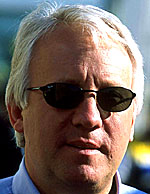 In this brief Q&A provided by the FIA, its Race Director and Safety Delegate clarifies the new rear wing rules.
In this brief Q&A provided by the FIA, its Race Director and Safety Delegate clarifies the new rear wing rules.
The big news for the coming season is the moveable rear wing rule. If we have correctly understood, the system works in this way : There is an actuator to move the flap of the rear wing, this actuator is driven by each F1 driver and it is under the authority of race control. How is race control regulating this procedure?
There is an actuator in each wing which is under the control of the driver at all times, however, it can only be used when the on-board electronics (FIA ECU) notify the driver that he is authorised to use it.
Proximity to the car in front will be detected before the straight on which the wing may be activated, if the car behind is less than one second behind (as judged by the installed timing loops in the track) the driver will be told that his system is "armed", however, he may only use it when he reaches the designated point on the following straight. This point is likely to be 600 metres before the braking point for the following corner, this may however be adjusted according data gathered during testing and practice.
What was the thinking behind the introduction of this new regulation?
This was a proposal the teams made to the FIA with the sole purpose of improving overtaking potential, whilst not making it easy. The FIA is always willing to listen to suggestions for improving the spectacle and we have sought a solution which both pleases the teams and the spectators.
Are you not worried this might confuse the spectators?
There is no reason to suppose spectators will be confused. Operation of the wing as described above is simple, there will be marks (lines) on the track to show the area where proximity is being detected and a line across the track at the point where the drivers whose system is armed may deploy it. Furthermore, the television broadcasters will be sent a signal each time a system is armed and this will be displayed to the viewers.
Are you not sensitive to the comments that race control will determine the outcome of the race?
As explained above race control has no influence over the outcome of a race, cars will simply have to get within one second of the one in front, the system will be armed automatically and the driver can use it at the pre-determined point, there is no question of race control being able to intervene.
How will you stop drivers tail-ending the leader to then 'jump' on the final straight?
If a car is able to get within one second of the leader entering the last corner of the last lap it is unlikely that he would be able to pass him before the finish line. If a car can get within one second of any other car, the driver will have the opportunity open to him, irrespective of their relative race positions.
It should be remembered though that the distance over which the Drag Reduction System (DRS) may be used is going to be tuned with the intention of assisting the following driver, not guaranteeing him an overtaking manoeuvre.
How will this activation/action affect the speed of the car? It is true that the speed benefit will be around 6/7 km/h or more?
From the simulation work done so far the difference between a car with and without the DRS is likely to be in the region of 10-12km/h at the end of the straight.
Have you factored in the issue of reliability? After all electronic systems do sometimes go wrong?
We have written the software to allow a driver to override the system if, for example, the proximity detection failed for any reason. This would only be permitted if the team had been given a specific instruction to do so from the race director. Heavy penalties would be imposed for unauthorised use.
When do you expect that the final choice will be made in setting this new system up?
Having gathered the information we need in the final test this will happen during the coming days and the teams informed accordingly.
Will the FIA allocate a test session to evaluate this new system?
This has been discussed but no decision has been taken. We will discuss the possibility of using part of a free practice session in Melbourne with the teams on the day before first practice.
How does the moveable rear wing affect KERS?
The DRS will not affect KERS in any way, the latter may be used by all drivers at any time, the following driver of course may use both, they are however independent systems.

 In this brief Q&A provided by the FIA, its Race Director and Safety Delegate clarifies the new rear wing rules.
In this brief Q&A provided by the FIA, its Race Director and Safety Delegate clarifies the new rear wing rules.



















sign in